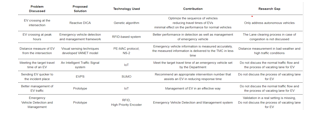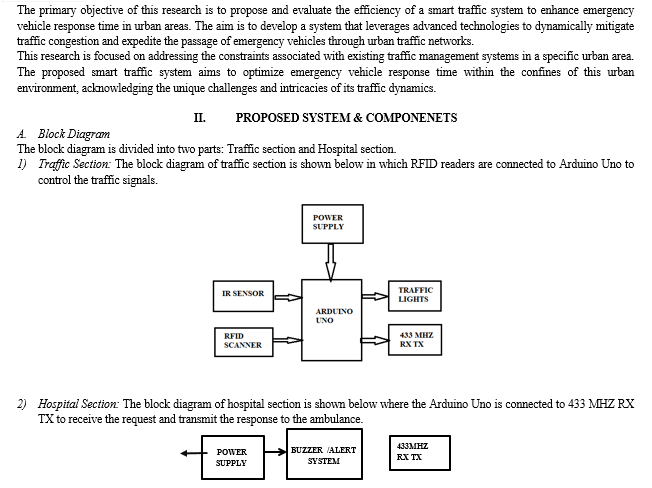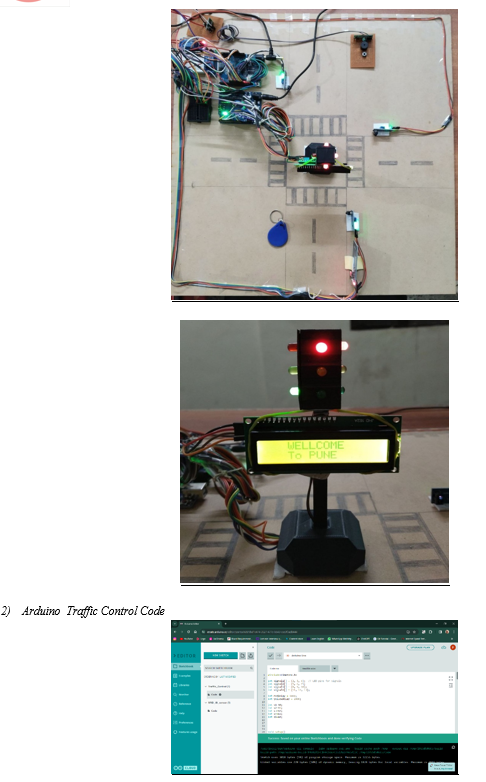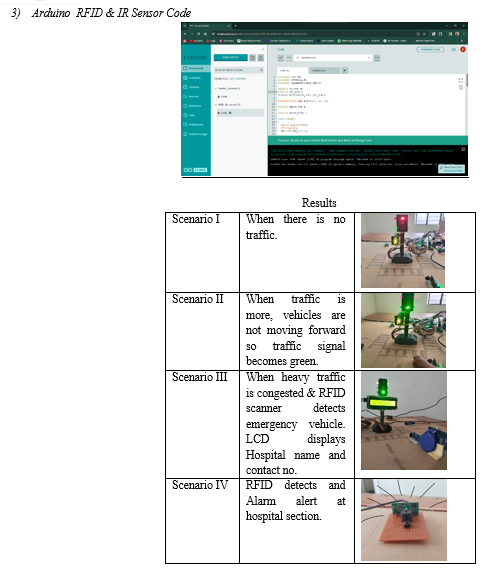Ijraset Journal For Research in Applied Science and Engineering Technology
- Home / Ijraset
- On This Page
- Abstract
- Introduction
- Conclusion
- References
- Copyright
Traffic Management System Using IOT
Authors: Prof. A. Y Prabhakar, V Gupta, P Bobade, S Gehlot
DOI Link: https://doi.org/10.22214/ijraset.2024.61122
Certificate: View Certificate
Abstract
Traffic congestion is a major threat to transportation sector in every urban city around the world. This causes many adverse effects like, heavy fuel consumption, increased waiting time, pollution, etc. and causes major challenge to the movement of emergency vehicles. The reaction time required by the emergency responders plays a vital role to handle the situation. The greatest challenge they face is congestion of traffic flow. This paper presents an approach to schedule emergency vehicles in traffic. The approach combines the controlling of traffic congestion by IR sensors and detection of emergency vehicle using by RFID scanner method. The IR sensors is responsible for vehicle counting and RFID for the emergency vehicle. An IR sensors continuously count the passing vehicles & records the delay time between two vehicles. Flow of vehicles is normal means there is smooth traffic flow, or if in case, the passing time between two vehicles is decreased that means traffic congestion is happen ahead. In this situation traffic light turns to green, so that the emergency vehicle will reach its destination as fast as possible. The aim of this article is to identify and monitor the congestion system in order to provide efficient facilities. This journal also sets out a method that uses 433 MHZ RF Transmitter and receiver Wireless communication device technique and Internet of Things (IoT) to transmit the treatment request from the ambulance to the nearby hospitals and at the same time the LCD is installed on the road junction which displays the nearby hospital name and contact number for the ambulance, this smart traffic system which in turn changes the traffic signal cycle. This system can be implemented throughout the city thereby to reducing the delay.
Introduction
I. INTRODUCTION
Traffic congestion reduction is the main goal in the development of efficient traffic control system. Many research works focus in the field of traffic safety control system. In addition, giving priority to the vehicle and changing the traffic signals must be the important functions for all the emergency vehicles to develop the safety measures in the road transportation. Ambulance and police vehicles are the emergency vehicles, must be reach the location without a maximum delay. The reaction time required by emergency responders plays major role in effectively addressing emergency situations, underscoring the urgency of mitigating traffic congestion to facilitate expedited response. The advanced development in electronics and communication systems provides different traffic control techniques. Historically, in urban areas across the globe, traffic congestion represents a pervasive and multifaceted challenge that significantly impacts the transportation sector and the overall quality of life for residents. The detrimental effects of traffic congestion extend beyond more inconvenience. However, the unique demands placed on emergency vehicles, such as ambulances and fire trucks, necessitate a specialized approach to traffic management. A comprehensive literature survey reveals a substantial research focused on traffic congestion management within urban environments. Existing studies have predominantly explored traditional traffic control mechanisms, including signal optimization, congestion pricing, and infrastructure enhancements, to ameliorate the challenges posed by congestion for regular commuter traffic. While these efforts have yielded advancements in conventional traffic management, there exists a notable gap in the literature concerning some specific considerations. The existing literature predominantly focuses on macro-level traffic congestion mitigation strategies, often neglecting the intricate micro-level considerations vital to facilitating swift emergency vehicle movement. The research gap thus encompasses the absence of a robust framework for integrating advanced technologies, such as real-time traffic monitoring, predictive analytics, and dynamic traffic signal control, to afford priority to emergency vehicles amidst urban traffic congestion.


B. Hardware Components
- IR Sensor: An Infrared sensor is an electronic device that are going to be deployed some distance away from road junction. These IR sensors are used for sensing of vehicles.
- RFID (Radio Frequency Identification) Reader: It is a machine which uses frequency signals to transmit the information wireless network between it and an RFID tag/label to recognize, characterize and monitor properties. It is used to integrate an RFID tag. In this project, RFID readers are used, for detect the emergency vehicles. The transmitter and receiver pins of the RFID reader are connected to the transmitter and receiver of Microcontroller respectively. The reader then detects the information from the Tag and sends the perceived data through signal port to the Circuit board. It is one method of Automatic Identification and Data Coupling (AIDC).
- 433 MHZ RF Transmitter and receiver Wireless Device: This hybrid RF Transceiver Module provides a complete RF transmitter and receiver module solution which can be used to transmit data at up to 3KHz. The transmitter module is very simple to operate and offers low current consumption. Data can be supplied directly from a microprocessor or encoding device, thus keeping the component count down and ensuring a low hardware cost.
- Arduino Uno: It is an open source electronics platform based on easy to use hardware and software. It has 14 digital input or output pins. It is used in traffic section to control the signals, ambulance section to transmit a request to the hospital and hospital section to transmit an acknowledgement to the ambulance section.
- Memory Card: A memory card is an electronic data storage device used for storing digital information, typically the program code using flash memory.
- Power Supply Battery: A 5V 2A SMPS Power Supply is used to convert incoming alternating current power into regulated direct current voltage and current. The 5V 2A rating means that the power supply can deliver a constant output voltage of 5 volts and a maximum output current of 2 amps.
- LCD Display: An electronic device that is used to display data and the message is shown on LCD 16×2. As the name suggests, it includes 16 Columns & 2 Rows so it can display 32 characters. This can display the nearby hospital name and contact number.
- Traffic Signal Lights: Traffic Lights are used to control vehicular traffic on the road and publics streets for the smooth traffic flow to avoid the traffic jams and accidents.
- I2C Driver: An I2C driver is a software component that enables communication between an Integrated Circuit (IC) master (host controller) and multiple I2C slave devices (peripherals) connected to the same I2C bus. The connection between the 433MHZ RX TX and arduino uno can be established with the help of I2C driver.
- Connecting Wires: A connecting wire is a flexible conductor that is used for the connection of all the components with each other.

- Include libraries and set pin modes
- Include any necessary libraries, such as those for the RFID reader, LCD screen, and sensor.
- Define the pin modes for the input and output pins. This will tell the Arduino board how to interpret the signals from the sensors and how to control the LCD screen and signal lights.
- Initialize threshold and LCD screen
- Set the threshold value for the sensor. This value will be used to determine whether a vehicle is considered to be passing through the fire hydrant.
- Initialize the LCD screen. This will prepare the screen to display information such as the sensor readings and the status of the system.
- Read sensors
- Read the values from the sensors. These sensors could be, for example, ultrasonic sensors that can detect the presence of a vehicle, or pressure sensors that can detect if a vehicle is driving over the fire hydrant.
- Check if vehicle passed
- Compare the sensor readings to the threshold value. If the sensor readings are above the threshold, then the system determines that a vehicle has passed through the fire hydrant.
- Check for EV with RFID
- If a vehicle is detected by the sensors, check if it is an electric vehicle (EV) using the RFID reader. This could be done by having the EV tags contain an RFID chip that the reader can identify.
- Increment counter if not EV
- If the vehicle is not an EV, increment a counter. This counter will be used to track the number of non-EVs that have passed through the fire hydrant.
- Check if counter equals threshold
- Compare the counter value to the threshold value. If the counter value equals the threshold value, then the system determines that too many non-EVs have passed through the fire hydrant.
- Turn signal lights to green if counter less than threshold
- If the counter value is less than the threshold value, then the system turns the signal lights to green, allowing traffic to proceed.
- Display data on LCD
- Display the sensor readings, the counter value, and the status of the system (e.g., "green light", "red light") on the LCD screen.
- Loop
- Return to step 3 and continue reading the sensors.
- This is a basic plan of action for the flowchart. The specific details of your implementation may vary depending on the specific sensors and components you are using.
- Here are some additional things to consider:
- You may want to add a safety feature to the system that prevents the signal lights from turning green if a vehicle is still detected by the sensors.
- You may want to keep track of the total number of vehicles that pass through the fire hydrant, regardless of whether they are EVs or not.
- You may want to add functionality to the system that allows authorized vehicles (e.g., emergency vehicles) to pass through the fire hydrant regardless of the signal light status.
IV. STEP-BY-STEP PROCEDURE
- Step 1: Hardware Setup
- Connection of IR and RFID sensor to the correct input pins on the Arduino.
- Connection of LCD display to the Arduino
- Similarly, to make sure it is powered correctly and connected to the designated input pins.
2. Step 2: Arduino Programming for IR Sensor
- Program in the Arduino IDE that reads data from the IR sensor.
- Setting up a threshold value for congestion detection. When the sensor detects a vehicle density exceeding the threshold, trigger the traffic light to switch to green.
3. Step 3: Arduino Programming for RFID Sensor
- Program to continuously search for RFID signals from emergency vehicles within its range.
- When an emergency vehicle is detected, retrieve its unique ID or other information stored in the RFID tag.
4. Step 4: Integration of IR and RFID Programs
- Merge the programs for the IR sensor and RFID sensor to work concurrently on the Arduino board.
- Setting up a mechanism to prioritize the RFID signal over the IR sensor if both congestion and an emergency vehicle are detected simultaneously.
5. Step 5: LCD Display and Traffic Light Control
- Implementing code to display relevant information (hospital name and contact number) on the LCD display.
- Control the traffic light to switch to green when heavy congestion is detected.
6. Step 6: Paramedics Interaction
- The paramedics inside the ambulance access the contact number displayed on the displayed with hospital name.
- The hospital make necessary medical arrangements for the patient.
7. Step 7: Testing and Optimization
- Testing the entire system thoroughly to ensure seamless integration and functionality.
- Optimizing the code for better performance and responsiveness.
8. Step 8: Deployment
- Once the testing results are satisfied, deployment of the system at the desired road junction.
- Monitoring the system's performance in real-world scenarios and make any necessary adjustments.
V. HARDWARE TOOLS & SOFTWARE
A. Hardware Tools
- Arduino Board (Uno)
- Power Supply for Arduino and sensors
- Tools for soldering and assembling components.
- RFID tags (for testing)
- Traffic Light System
B. Software
- Arduino IDE - for programming the Arduino board
- RFID Library for Arduino - for working with RFID sensors
- LCD Library for Arduino - for controlling the LCD display
VI. RESULS & DISCUSSION
The proposed output has been explained using Figs.
In traffic section, whenever, there is congestion of vehicle raises, IR sensor will detect the traffic congestion, once heavy congestion detected the traffic light get triggered to green signal and at the same time hospital name with contact number is displayed on the LCD display, fixed at the road junction. Along with IR sensor for the traffic management, at the same time RFID continuously search for the emergency vehicle in the traffic within its range. The programming of IR and RFID sensor using the Arduino software which provides the development environment.
ARDUINO SOFTWARE IDE is used for searching the nearest hospital and responsible for providing data on the LCD display, once the data is displayed on the LCD, the paramedics inside the ambulance, contact to the hospital and make the necessary arrangements for the patient in the hospital section.



Conclusion
A. Objective The primary objective of this system was to enhance traffic management during congestion, promptly detect emergency vehicles using RFID technology, and facilitate quick communication between paramedics and hospitals. The integration of IR and RFID sensors with Arduino, coupled with the use of an LCD display and traffic lights, aimed to create an intelligent traffic control and emergency response system. B. Review of Key Findings Through the implementation and testing of the system, it was observed that the IR sensor effectively detected traffic congestion, triggering the traffic light to green and displaying relevant hospital information on the LCD display. Simultaneously, the RFID sensor successfully identified emergency vehicles within its range, providing essential data for swift response and communication. C. Implication or Application The developed system has significant implications for urban traffic management and emergency services. By dynamically adjusting traffic lights based on real-time congestion data, the system contributes to smoother traffic flow. Additionally, the RFID technology ensures the prioritized passage of emergency vehicles, minimizing response times and enhancing overall road safety. The LCD display serves as an informative interface, displaying critical hospital information during emergencies. D. Recommendation for Future Work 1) Integration with Smart City Infrastructure: Explore the integration of the system with broader smart city initiatives, allowing for seamless communication with other urban systems such as traffic cameras, emergency services, and central control centers. 2) Enhanced Hospital Search: Invest in developing more sophisticated algorithms for hospital selection, considering factors like real-time hospital occupancy, specialized medical services, and road conditions for optimized emergency response. 3) Advanced Communication Features: Incorporate advanced communication modules, such as 5G or satellite communication, to improve the reliability and speed of communication between emergency vehicles and hospitals. 4) Expandability for Additional Sensors: Design the system with expandability in mind, allowing for the integration of additional sensors or technologies that can further enhance traffic management and emergency response. 5) User Feedback and Iterative Improvements: Collect feedback from emergency services, paramedics, and city authorities to make iterative improvements. This involves refining the system based on real-world usage and addressing any challenges or limitations identified during deployment.
References
[1] Younes, M.B.; Boukerche, A. An efficient dynamic traffic light scheduling algorithm considering emergency vehicles for intelligent transportation systems. Wirel. Netw. 2018, 24, 2451–2463. [2] Sumi, L.; Ranga, V. Intelligent traffic management system for prioritizing emergency vehicles in a smart city. Int. J. Eng. 2018, 31, 278–283. [3] Lu, Q.; Kim, K.-D. A genetic algorithm approach for expedited crossing of emergency vehicles in connected and autonomous intersection traffic. J. Adv. Transp. 2017, 2017, 1–15. [4] Bhate, S.V.; Kulkarni, P.V.; Lagad, S.D.; Shinde, M.D.; Patil, S. IoT based intelligent traffic signal system for emergency vehicles. In Proceedings of the 2018 Second International Conference on Inventive Communication and Computational Technologies (ICICCT), Coimbatore, India, 20–21 April 2018. [5] Watanabe, B.L.; Patterson, G.S.; Kempema, J.M.; Magallanes, O.; Brown, L.H. Is use of warning lights and sirens associated with increased risk of ambulance crashes? A contemporary analysis using National EMS Information System (NEMSIS) data. Ann. Emerg. Med. 2019, 74, 101–109. [6] Naik, T.; Roopalakshmi, R.; Ravi, N.D.; Jain, P.; Sowmya, B.H.; Manichandra. RFID-based smart traffic control framework for emergency vehicles. In Proceedings of the 2018 Second International Conference on Inventive Communication and Computational Technologies (ICICCT), Coimbatore, India, 20–21 April 2018. [7] Nellore, K.; Hancke, G.P. Traffic management for emergency vehicle priority based on visual sensing. Sensors 2016, 16, 1892. [8] Chowdhury, A. Priority based and secured traffic management system for emergency vehicle using IoT. In Proceedings of the 2016 International Conference on Engineering & MIS (ICEMIS), Agadir, Morocco, 22–24 September 2016. [9] Karmakar, G.; Chowdhury, A.; Kamruzzaman, J.; Gondal, I. A smart priority based traffic control system for emergency vehicles. IEEE Sens. J. 2020, 21, 15849–15858. [10] Tammishetty, S.; Ragunathan, T.; Battula, S.K.; Rani, B.V.; Ravi Babu, P.; Nagireddy, R.; Jorika, V.; Reddy, V.M. IOT-based traffic signal control technique for helping emergency vehicles. In Proceedings of the First International Conference on Computational Intelligence and Informatics; Springer: Berlin/Heidelberg, Germany, 2017. [11] Amir, S.; Kamal, M.S.; Khan, S.S.; Salam, K.M.A. PLC based traffic control system with emergency vehicle detection and management. In Proceedings of the 2017 International Conference on Intelligent Computing, Instrumentation and Control Technologies (ICICICT), Kerala, India, 6–7 July 2017. [12] Khan, A.; Ullah, F.; Kaleem, Z.; Rahman, S.U.; Anwar, H.; Cho, Y.-Z. EVP-STC: Emergency vehicle priority and self-organising traffic control at intersections using Internet-of-things platform. IEEE Access 2018, 6, 68242–68254. [13] Avatefipour, O.; Sadry, F. Traffic management system using IoT technology—A comparative review. In Proceedings of the 2018 IEEE International Conference on Electro/Information Technology (EIT), Rochester, MI, USA, 3–5 May 2018. [14] Awan, K.A.; Din, I.U.; Almogren, A.; Kim, B.S.; Altameem, A. vTrust: An IoT-Enabled Trust-Based Secure Wireless Energy Sharing Mechanism for Vehicular Ad Hoc Networks. Sensors 2021, 21, 7363. [15] Humayun, M.; Jhanjhi, N.; Hamid, B.; Ahmed, G. Emerging smart logistics and transportation using IoT and blockchain. IEEE Internet Things Mag. 2020, 3, 58–62. Humayun, M.; Jhanjhi, N.; Hamid, B.; Ahmed, G. Emerging smart logistics and transportation using IoT and blockchain. IEEE Internet Things Mag. 2020, 3, 58–62. [16] Wu, J.; Kulcsár, B.; Ahn, S.; Qu, X. Emergency vehicle lane pre-clearing: From microscopic cooperation to routing decision making. Transp. Res. Part B Methodol. 2020, 141, 223–239. [17] Li, B.; Zhang, Y.; Jia, N.; Zhou, C.; Ge, Y.; Liu, H.; Meng, W.; Ji, C. Paving green passage for emergency vehicle in heavy traffic: Real-time motion planning under the connected and automated vehicles environment. In Proceedings of the 2017 IEEE International Symposium on Safety, Security and Rescue Robotics (SSRR), Shanghai, China, 11–13 October 2017. [18] Akabane, A.T.; Immich, R.; Bittencourt, L.F.; Madeira, E.R.; Villas, L.A. Towards a distributed and infrastructure-less vehicular traffic management system. Comput. Commun. 2020, 151, 306–319.
Copyright
Copyright © 2024 Prof. A. Y Prabhakar, V Gupta, P Bobade, S Gehlot. This is an open access article distributed under the Creative Commons Attribution License, which permits unrestricted use, distribution, and reproduction in any medium, provided the original work is properly cited.

Download Paper
Paper Id : IJRASET61122
Publish Date : 2024-04-27
ISSN : 2321-9653
Publisher Name : IJRASET
DOI Link : Click Here
 Submit Paper Online
Submit Paper Online

